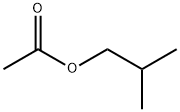-
外観
無色澄明の液体
-
種類
酢酸イソブチルは、主に研究開発用試薬製品や、工業用化学薬品として販売されている物質です。
1. 研究開発用試薬製品
研究開発用試薬製品 実験室で取り扱いやすい容量での提供が一般的です。通常、室温で取り扱い可能な試薬製品として販売されています。
2. 工業用化学薬品
工業用化学薬品 主に工業用溶剤として用いられることが多いです。
-
性質
酢酸イソブチルは分子量116.16、融点-98.8℃、沸点116.5℃であり、常温での外観は無色澄明の液体です。臭いは特異臭と形容される果実臭です。自然界ではラズベリーやバナナ、梨の香気成分に含まれています。
密度は0.873g/mLです。及び等の有機溶媒に極めて溶けやすく、水には溶けにくい性質があります。水への溶解度は0.67g/100mL (20℃) です。引火点は18℃であり、引火性の高い物質といえます。
-
定義
本品は、酢酸(*)とイソブチルアルコールのエステルであり、次の化学式で表される。
参照表示名称:酢酸
-
溶解性
水に微溶 (0.6ml/100ml水, 25℃), アルコール, エーテル混和。エタノール及びアセトンに極めて溶けやすく、水に溶けにくい。
-
解説
酢酸イソブチル (英: Isobutyl acetate) とは、カルボン酸エステルに分類され、化学式C6H12O2で表される有機化合物の1種です。
IUPAC命名法による名称は酢酸 2-メチルプロピルであり、その他の別名に、酢酸2-メチルプロピルエステル、ブチルエタノエートという名称があります。CAS登録番号は110-19-0です。
カルボン酸エステル特有の果実臭を特徴としており、バナナの香りの主成分であるとされています。
-
用途
香料原料、塗料
-
用途
農薬(殺菌剤)、農薬原料、医薬、防腐剤、化学繊維製造凝固剤、メッキ、蛍光隊原料、飼料添加物
-
化粧品の成分用途
溶剤、香料
-
合成

酢酸イソブチルの合成
酢酸イソブチルは、酢酸とイソブチルアルコールが縮合したカルボン酸エステルに相当します。合成方法としては、他のエステルと同様に、濃硫酸などの酸触媒や脱水剤の存在下、酢酸とイソブチルアルコールを混合、加熱する方法 (フィッシャーエステル合成反応) や、酢酸ハライドや無水酢酸を用いる方法などが挙げられます。
工業的には、イソブチルアルコールを酢酸で直接エステル化することにより製造されます。
-
説明
Isobutyl acetate has a fruity (currant-pear), floral (hyacinth-rose)
odor and a characteristic ether-like, slightly bitter flavor. May be
prepared by direct esterification of isobutyl alcohol with acetic
acid.
-
化学的特性
Isobutyl acetate is a colorless liquid with a fruit flavor. Isobutyl acetate is moisture sensitive, incompatible with ignition sources, moisture, excess heat, strong oxidizing agents, and strong bases; on decomposition, it releases carbon monoxide and carbon dioxide. It is used for nitrification fiber and paint solvents, chemical reagents, and modulation spices
-
物理的性質
Colorless liquid with a fruity odor. Experimentally determined detection and recognition odor
threshold concentrations were 1.7 mg/m3 (360 ppbv) and 2.4 mg/m3 (510 ppbv), respectively
(Hellman and Small, 1974).
-
天然物の起源
Reported found in, apple, apricot, banana, currants, guava, grapes, melon, pear, blackcurrant, papaya, pine�apple, strawberry, vinegar, wheat bread, Parmesan and Gruyere cheese, beef fat, beer, cognac, rum, cider, whiskies, sherry, grape
wines, port, olive, cocoa, passion fruit, plum, starfruit, bantu beer, plum and grape brandy, mango, tamarind, apple brandy, figs, plum
wine, litchi, sake, nectarine, naranjilla fruit, Cape gooseberry and Roman chamomile oil.
-
使用
Isobutyl Acetate is a flavoring agent that is a clear colorless liquid
with a fruity odor resembling banana when diluted. it is soluble in
alcohol, propylene glycol, most fixed oils, and mineral oil, and
slightly soluble in water. it is obtained by synthesis.
-
定義
ChEBI: The acetate ester of isobutanol.
-
製造方法
By direct esterification of isobutyl alcohol with acetic acid.
-
調製方法
Isobutyl acetate may be made from methyl isobutyl
ketone. It may also be made by treating isobutanol
with acetic acid in the presence of catalysts. The
Tischenko reaction of acetaldehyde with isobutyraldehyde
yields a mixture of isobutyl acetate with ethyl acetate and
isobutyl isobutyrate.
-
一般的な説明
A clear colorless liquid with a fruity odor. Flash point 64°F. Less dense than water (6.2 lb / gal) and insoluble in water. Vapors are heavier than air .
-
空気と水の反応
Highly flammable. Insoluble in water.
-
反応プロフィール
Isobutyl acetate reacts exothermically with acids to give alcohols and other acids. May react sufficiently exothermically with strong oxidizing acids to ignite the reaction products. Reactions with bases also generate heat. Combination with strong reducing agents (alkali metals and hydrides) generates flammable hydrogen.
-
危険性
Flammable, dangerous fire risk.
-
健康ハザード
Isobutyl acetate is more toxic but less of anirritant than n-butyl acetate. The toxic symp toms include headache, drowsiness, irritationof upper respiratory tract, and anesthesia.A 4-hour exposure to 8000 ppm was lethalto rats. It produced mild to moderate irri tation on rabbits’ skin. The irritation ineyes was also mild to moderate. The LD50oral value in rabbit is within the range4800 mg/kg.
-
火災危険
HIGHLY FLAMMABLE: Will be easily ignited by heat, sparks or flames. Vapors may form explosive mixtures with air. Vapors may travel to source of ignition and flash back. Most vapors are heavier than air. They will spread along ground and collect in low or confined areas (sewers, basements, tanks). Vapor explosion hazard indoors, outdoors or in sewers. Runoff to sewer may create fire or explosion hazard. Containers may explode when heated. Many liquids are lighter than water.
-
有害性
酢酸イソブチルは物理化学的危険性や人体への有害性が指摘されている物質です。GHS分類では、下記のように分類されています。
取り扱いの際は適切な局所排気装置や全体換気を設置し、保護メガネや保護衣などの適切な個人用保護具を着用することが必要です。
- 引火性液体: 区分2
- 健康に対する有害性 急性毒性 (吸入: 蒸気) : 区分4
- 眼に対する重篤な損傷性又は眼刺激性 : 区分2B
- 特定標的臓器毒性 (単回ばく露) : 区分3 (気道刺激性、麻酔作用)
-
法規制情報
酢酸イソブチルは、前述の有害性のため、法令によって規制を受ける物質です。労働安全衛生法では、危険物・引火性の物、名称等を表示すべき危険有害物、名称等を通知すべき危険有害物、リスクアセスメントを実施すべき危険有害物、第2種有機溶剤等、作業環境評価基準に指定されています。
消防法においては、第4類引火性液体、第一石油類非水溶性液体に分類されている物質です。法令を遵守して正しく取り扱うことが必要といえます。
-
使用用途

図2. 酢酸イソブチルとフェニル酢酸イソブチルの構造
酢酸イソブチルは、主に化学工業において、脱水剤、塗料 (・など) ・インキ用溶剤、、反応溶媒、抽出溶剤、化学繊維製造凝固剤、メッキ、蛍光体原料などの幅広い用途を持つ物質です。酢酸イソブチルは、エステル類特有の果実臭を持つため、香水や食品添加物としても用いられます。
なお、関連物質であるα位がフェニル基で置き換わったフェニル酢酸イソブチルは、バラの香りの香料として、食品衛生法で食品添加物に指定されている物質です。それ以外の酢酸イソブチルの用途としては、農薬 (殺菌剤) 、農薬原料、医薬、飼料添加物などの用途が挙げられます。
-
化学反応性
Reactivity with Water No reaction; Reactivity with Common Materials: Softens and dissolves many types of plastics; Stability During Transport: Stable; Neutralizing Agents for Acids and Caustics: Not pertinent; Polymerization: Not pertinent; Inhibitor of Polymerization: Not pertinent.
-
職業ばく露
n-Butyl acetate is an important solvent
in the production of lacquers, leather and airplane dopes,
and perfumes. It is used as a solvent and gasoline additive.
sec-Butyl acetate is used as a widely used solvent for
nitrocellulose, nail enamels and many different purposes.
tert-Butyl acetate is common industrial solvent used in the
making of lacquers, artificial leather, airplane dope, perfume; and as a food additive. Isobutyl acetate is used as a
solvent and in perfumes and artificial flavoring materials
-
環境運命予測
Chemical/Physical. Slowly hydrolyzes in water forming 2-methylpropanol and acetic acid.
At an influent concentration of 1,000 mg/L, treatment with GAC resulted in an effluent
concentration of 180 mg/L. The adsorbability of the carbon used was 164 mg/g carbon (Guisti et
al., 1974).
-
輸送方法
UN1123 Butyl acetates, Hazard Class: 3; Labels:
3—Flammable liquid.
-
不和合性
All butyl acetates are incompatible with
nitrates, strong oxidizers; strong alkalies; strong acids.
Butyl acetates may form explosive mixture with air; reacts
with water, on standing, to form acetic acid and n-butyl
alcohol. Violent reaction with strong oxidizers and
potassium-tert-butoxide. Dissolves rubber, many plastics,
resins and some coatings. May accumulate static electrical
charges, and may cause ignition of its vapors
-
廃棄物の処理
Dissolve or mix the material
with a combustible solvent and burn in a chemical
incinerator equipped with an afterburner and scrubber.
All federal, state, and local environmental regulations
must be observed.




